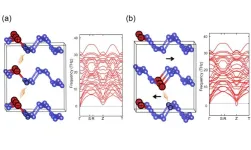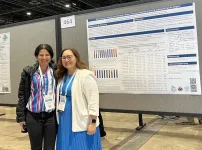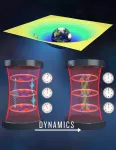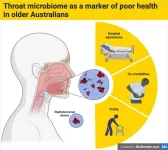(Press-News.org) Using first-principles calculations, a research group led by Prof. WANG Xianlong from the Hefei Institutes of Physical Science of the Chinese Academy of Sciences, found that phosphorus doping is an effective way to achieve high-energy polymeric nitrogen with black-phosphorus structure (BP-N) stable at ambient pressure.
The research results were published in Matter and Radiation at Extremes.
Cubic gauche nitrogen with diamond-like structure and BP-N with black phosphorus structure, represented by polymeric all-nitrogen materials, are a class of high-energy density materials composed entirely of N-N single bonds, but their samples synthesized under high-pressure conditions cannot be preserved under ambient pressure, which is one of the important challenges faced in this field.
In this study, researchers found that the low-pressure instability mechanism of BP-N is different from that of cg-N.
The surface instability of cg-N leads to structural instability, while the bulk of BP-N will decompose into nitrogen chains at low-pressure range. Phosphorus atom doping can suppress the bulk decomposition of BP-N and stabilize BP-N to 0 GPa, achieving dynamical stability through N-P dipole interaction.
In addition, the researchers calculated the optimal doping concentration and detonation performance of BP-N.
This research result will actively promote the ambient pressure synthesis and large-scale preparation of BP-N.
END
Phosphorus doping stabilizes high-energy polymeric nitrogen at ambient pressure
2025-03-06
ELSE PRESS RELEASES FROM THIS DATE:
Maternal cannabis use triples risk of disruptive behaviour in children
2025-03-06
Children exposed to their mother’s cannabis use during pregnancy and after birth are three times more likely to develop behavioural problems, new Curtin University research has found.
Published in Psychiatry Research, the study analysed data from more than 222,600 Australian mothers and children, revealing maternal cannabis use disorder (CUD) during pregnancy and the postnatal period significantly increased the risk of childhood disruptive behavioural disorders.
Lead researcher Abay Tadesse, from Curtin’s School of Population ...
Balancing Nutrition: Micronutrient study could help prevent childhood obesity in Pacific region
2025-03-06
Children ages two to eight years across 11 Pacific jurisdictions (Alaska, American Samoa, Commonwealth of the Northern Mariana Islands, Federated States of Micronesia, Guam, Hawai‘i, Marshall Islands, and Palau) are not meeting daily recommended intakes for key micronutrients, either consuming too much or too little. That discovery was published recently in a study led by scientists at the University of Hawai‘i (UH) at Mānoa. The research team also found associations between children’s micronutrient intake, obesity, and presence of acanthosis nigricans, a skin condition that is ...
Lightening the load of augmented reality glasses
2025-03-06
An international team of scientists developed augmented reality glasses with technology to receive images beamed from a projector, to resolve some of the existing limitations of such glasses, such as their weight and bulk. The team’s research is being presented at the IEEE VR conference in Saint-Malo, France, in March 2025.
Augmented reality (AR) technology, which overlays digital information and virtual objects on an image of the real world viewed through a device’s viewfinder or electronic display, has gained traction in recent years with popular gaming apps like Pokémon Go, and real-world applications in areas including education, manufacturing, ...
Sneaky clocks: uncovering Einstein’s relativity in an interacting atomic playground
2025-03-06
For over a century, physicists have grappled with one of the most profound questions in science: How do the rules of quantum mechanics, which govern the smallest particles, fit with the laws of general relativity, which describe the universe on the largest scales?
The optical lattice clock, one of the most precise timekeeping devices, is becoming a powerful tool used to tackle this great challenge. Within an optical lattice clock, atoms are trapped in a “lattice” potential formed by laser beams and are manipulated with precise control of quantum coherence and interactions governed by quantum mechanics. Simultaneously, ...
The chances of anything coming from Mars
2025-03-06
Within the next decade, space agencies plan to bring samples of rock from Mars to Earth for study. Of concern is the possibility these samples contain life, which could have unforeseen consequences. Therefore, researchers in this field strive to create methods to detect life. For the first time, researchers, including those from the University of Tokyo and NASA, successfully demonstrated a method to detect life in ancient rocks analogous to those found on Mars.
We’ve all seen the movies, in which “Scientists bring back something from space, ...
Scientists unlock clues to new treatments for muscular dystrophy
2025-03-06
A new discovery about how tiny protein clusters form in cells could pave the way for treatments for Emery-Dreifuss muscular dystrophy (EDMD), a rare genetic disorder that causes muscle weakness and heart problems.
Researchers at the USC Dornsife College of Letters, Arts and Sciences combined advanced imaging techniques and theoretical physics to observe and explain how nanoclusters of the protein emerin form inside living cells. These clusters — about 100,000 times smaller than a human hair’s width — play a crucial role in how cells sense and respond to mechanical forces like stretching or pressure, ...
Anti-obesity drugs benefit kidney transplant recipients with type 2 diabetes
2025-03-06
Kidney transplant recipients with type 2 diabetes treated with a new class of anti-obesity drugs were less likely to experience organ failure and survived longer, a new study shows. Not only is obesity a known risk factor for diabetes, but it also increases risk of postsurgical complications, such as inflammation, organ rejection, and early death.
Previous research had suggested some benefit for kidney transplant recipients with a history of type 2 diabetes who took the medications, originally designed to treat diabetes, at some point after their transplant ...
Cases of Parkinson’s disease set to reach 25 million worldwide by 2050
2025-03-06
By 2050, there will be 25.2 million people living with Parkinson’s disease worldwide (a 112% increase from 2021), largely due to population ageing, suggests a modelling study published by The BMJ today.
Overall, the number of people living with Parkinson’s disease (all age prevalence) per 100,000 population is predicted to increase by 76%, and by 55% when corrected for age differences (age standardised prevalence), with rates projected to be highest in East Asia.
The researchers say these projections “could serve as an aid in promoting health research, ...
Throat microbiome holds clues to older Australians’ health
2025-03-06
New research by Flinders University has uncovered a potential marker that could provide valuable insights into the overall health of older adults living in long-term aged care facilities.
Led by PhD candidate Sophie Miller in the College of Medicine and Public Health, the study found that a simple swab from the back of the throat, known as the oropharynx, may offer clues about health challenges faced by aged care residents.
“Our findings suggest that certain bacteria detected in the back of the throat could indicate greater health vulnerability in older adults,” says Miller.
Identifying vulnerable individuals ...
Diabetes drug could help cancer patients make better recovery
2025-03-06
A common type of diabetes medication could help cancer patients make a better long-term recovery, according to new research from the University of East Anglia.
Many cancer patients go on to develop heart failure - because of the cancer itself and also due to chemotherapy. This can lead to a reduced quality of life, multiple admissions to hospital or even death.
But a new study published today shows that a type of diabetes medication, called an SGLT2 inhibitor, may help protect the ...





